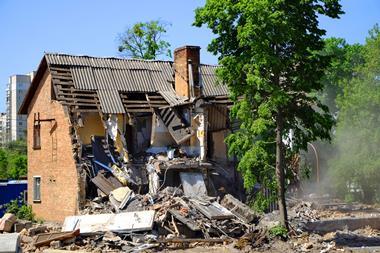Business size affects insurers’ buoyancy in the property insurance market after 2020 brought business interruption claims and storm losses to firms’ doorsteps
UK property insurers have fallen to an underwriting loss for the second time in three years, according to analysis of the industry’s latest Solvency and Financial Condition Reports (SFCRs) conducted by Insurance DataLab and published exclusively by Insurance Times.
The property insurance market’s aggregate combined operating ratio (COR) jumped 11.5 percentage points to 110.2% for 2020, up from 98.7% for the previous year.
This worsening of the overall performance was driven by an 11.3 percentage point increase in the sector’s loss ratio, which climbed to 62.8% for 2020 - up from 51.5% for 2019.
Insurers were negatively affected by an increase in natural catastrophe losses across the last year, with Willis Re figures revealing that global insured losses from major natural catastrophes totalled roughly $78bn (£56.6bn) for 2020.

This is the fourth largest total since 2011 and is about 17% higher than the 10-year average of $66.5bn.
The UK, meanwhile, was hit by the wettest February on record in 2020. More than half a dozen storms caused travel problems, flooding and infrastructure damage across the country.
Net incurred claims across UK property insurers rose by almost a fifth during 2020, totalling more than £4.6bn - up from £3.9bn a year earlier.
While gross written premiums (GWP) for property insurance rose by 7.3% last year, net earned premiums fell by 2.6% as insurers ceded additional premiums to reinsurers – although this increase in reinsurance cover was not enough to offset the rise in claims experienced over the year.
Several insurers also came under additional pressure thanks to a drop in premiums resulting from a reduction in cover due to the impact of the Covid-19 pandemic. Many insurers’ property books were also hit by a rise in business interruption (BI) claims stemming from social distancing restrictions imposed during the pandemic.
Size matters
Deeper analysis of these figures, however, reveals that property market performance over the last 12 months has varied greatly depending on the size of the insurer.
Indeed, insurers that fell within the middle two quartiles of the market by GWP actually recorded an underwriting profit for 2020, reporting an aggregate COR of 97.4%.
This is an improvement on both the 100.8% reported for 2019 and the 116.6% recorded for 2018, making it two consecutive years of improvement for mid-sized insurers.
Smaller insurers reported the worst underwriting performance in 2020, with an aggregate COR of 192.3%, although this was driven by several exceptionally large losses across the likes of Markel International, Great American International Insurance (UK) and Pinnacle Insurance – all of which reported 2020 property CORs in excess of 400%.
If these three insurers are excluded from the calculations, then the aggregate COR for the remaining small insurers would stand at 106.9%, which, while still in loss-making territory, is much lower than the 192.3% reported across all small insurers.
Larger insurers, meanwhile, reported a COR of 110.5% for 2020 - a worsening on the profit-making 98.4% reported for 2019 and the 107.1% noted for 2018.
Of the 10 largest property insurers by GWP, Lloyds Bank achieved the best underwriting performance, reporting a COR of 89.2% for 2020. This makes it one of just two insurers from the top 10 to report an underwriting profit, alongside Direct Line Group with a COR of 94.8%.
Lloyds Bank’s overall performance was underpinned by a market-leading loss ratio of 42.9%, an achievement made despite the insurer’s loss ratio climbing by a little under four percentage points over the course of 2020.

Loss ratio fluctuations
The only insurer from the top 10 property insurers to report an improving loss ratio was RSA – its loss ratio fell 1.2 percentage points to 54.9% for 2020.
This is an improvement on the 56.1% loss ratio it reported for 2019 and the 60% it recorded for 2018, making it two consecutive years of improving loss ratios for the insurer.
Despite this improvement in its loss ratio, RSA’s overall property COR still jumped 5.8 percentage points in 2020 to 106.9%, after its expense ratio for the year rose to 51.9% (2019: 45%).
AIG, meanwhile, reported the biggest loss ratio increase across the top 10 property insurers, with its 2020 loss ratio of 68% being 44 percentage points higher than the 24% loss ratio it reported for 2019, which was the first year in which the insurer reported separate figures for its UK operations. The insurer’s net incurred claims grew by almost £100m over the course of the last 12 months.
The highest loss ratio of the top 10 insurers, however, was the 102.9% reported by NFU Mutual. The insurer has reported the highest loss ratio in each of the last three years, although its 2020 ratio was particularly high after growing by more than 25 percentage points.
NFU Mutual’s market-leading expense ratio of 22.5% meant that it reported a COR of 125.4% – the third highest in this analysis of the 10 largest property insurers.
The highest COR, meanwhile, was reported by Allianz. The insurer recorded a COR of 148.5% for 2020, up from 113.5% the previous year and 109.6% for 2018 as the company continues to struggle with worsening underwriting results.
This rise in Allianz’s combined ratio was driven by an uptick in claims that saw net incurred claims rise to £256m – a 51% increase on the £169.7m worth of claims received a year earlier.
This resulted in the insurer reporting a loss ratio of 100.7% for 2020, compared to loss ratios of 64.9% and 60% for 2019 and 2018 respectively.
In its annual report for 2020, Allianz cited Covid-19 as one of the main drivers behind the weaker performance of its commercial property portfolio, with the insurer saying the line had been “heavily impacted” by BI claims.
The insurer estimated that these BI claims amounted to £175m net of reinsurance - Allianz said that it “has continued to review the applicability of coverage as the FCA test case has developed”.
The German insurer also pointed to storms Ciara and Dennis, which hit the UK during the first quarter of 2020, as other drivers behind its high property losses experienced over the course of last year.
When it comes to expenses, Legal and General reported the worst ratio of the top 10 property insurers, reporting an expense ratio of 82% for 2020, up from 68.4% in 2019 and 59.7% in 2018.
This, combined with a 2020 property loss ratio of 54.8%, meant that the now Allianz-owned insurer reported an overall property COR of 136.8% - the second highest of the 10 largest insurers in this analysis.
Growth and profit hard to come by

While only two of the insurers in the top 10 by property GWP were able to report an underwriting profit for 2020, profitable growth was even harder to come by.
Lloyds Bank, in addition to achieving the best COR of the year, was also the only insurer to grow is net earned premium (NEP) while also turning in an underwriting profit.
The insurer grew its property NEP by 2.7% over the last 12 months for a total of £493m, up from £480m in 2019.
The biggest growth in NEP, meanwhile, was reported by Ageas, with the insurer growing its property book by 12.8% to break through the £200m NEP barrier - but a COR of 108.9% for last year means the insurer was not able to report any profitable growth for 2020.
Despite being the second largest UK property insurer by GWP, RSA was the only insurer to report NEP north of £1bn. This is despite a greater than 10% drop in NEP to £1.2bn for 2020, down from £1.3bn a year earlier.
Future gazing
Looking to the future, commercial lines insurers will have been buoyed by rising property premiums, with data from broker Marsh’s Global Insurance Market Index - published in Q3 this year - revealing year-on-year increases of 18% and 15% for Q1 and Q2 2021 respectively.
These increases do, however, represent a downward trend on previous price movements after premiums rose by 24% in the fourth quarter of 2020.
This, combined with the continued economic pressures on businesses that will undoubtedly have a negative impact on overall premium levels, will be of concern to property insurers operating in the commercial space.
Meanwhile, home insurance premiums have been on a downward trajectory over the last 12 months, with data from Consumer Intelligence published in August 2021 showing that premiums have fallen by an average of 5.6% over the 12 months to the end of July 2021.
This will be of concern to property insurers at a time when claims have been rising and underwriting profits remain hard to come by.
The FCA’s general insurance pricing regulations that come into force at the beginning of 2022 will add further complications to a market that is already dealing with a number of pressures. It remains to be seen how insurers will respond to these changing market dynamics.
About Insurance DataLab

InsuranceDataLab.com is a new data insight service, focusing on the performance of insurers, Lloyd’s syndicates, MGAs and brokers based in the UK and Gibraltar.
With hundreds of thousands of data points covering almost £100bn in annual gross written premium and featuring more than 700 insurance companies and brands, InsuranceDataLab.com provides access to comparable industry data to help benchmark performance, assess existing and potential partners, and identify new opportunities.
Hosted by comedian and actor Tom Allen, 34 Gold, 23 Silver and 22 Bronze awards were handed out across an amazing 34 categories recognising brilliance and innovation right across the breadth of UK general insurance.





















































No comments yet